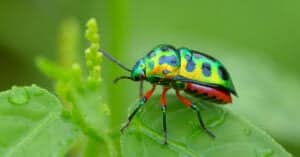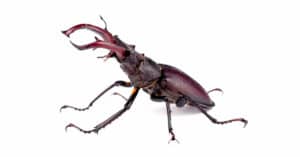Japanese beetles (Popillia japonica) are a species of scarab beetle that have made their mark as invasive intruders in various parts of the world, causing concerns for ecosystems, horticulture, and agriculture. Native to Japan, these beetles have become notorious for their voracious appetite and ability to wreak havoc on plants, making them a significant challenge for conservationists, farmers, and gardeners. This article will provide a brief overview of Japanese beetles to gain an understanding of their behavior and impact, measures being taken to control their populations as an invasive species, and smells and other methods that Japanese beetles hate that keep them away.
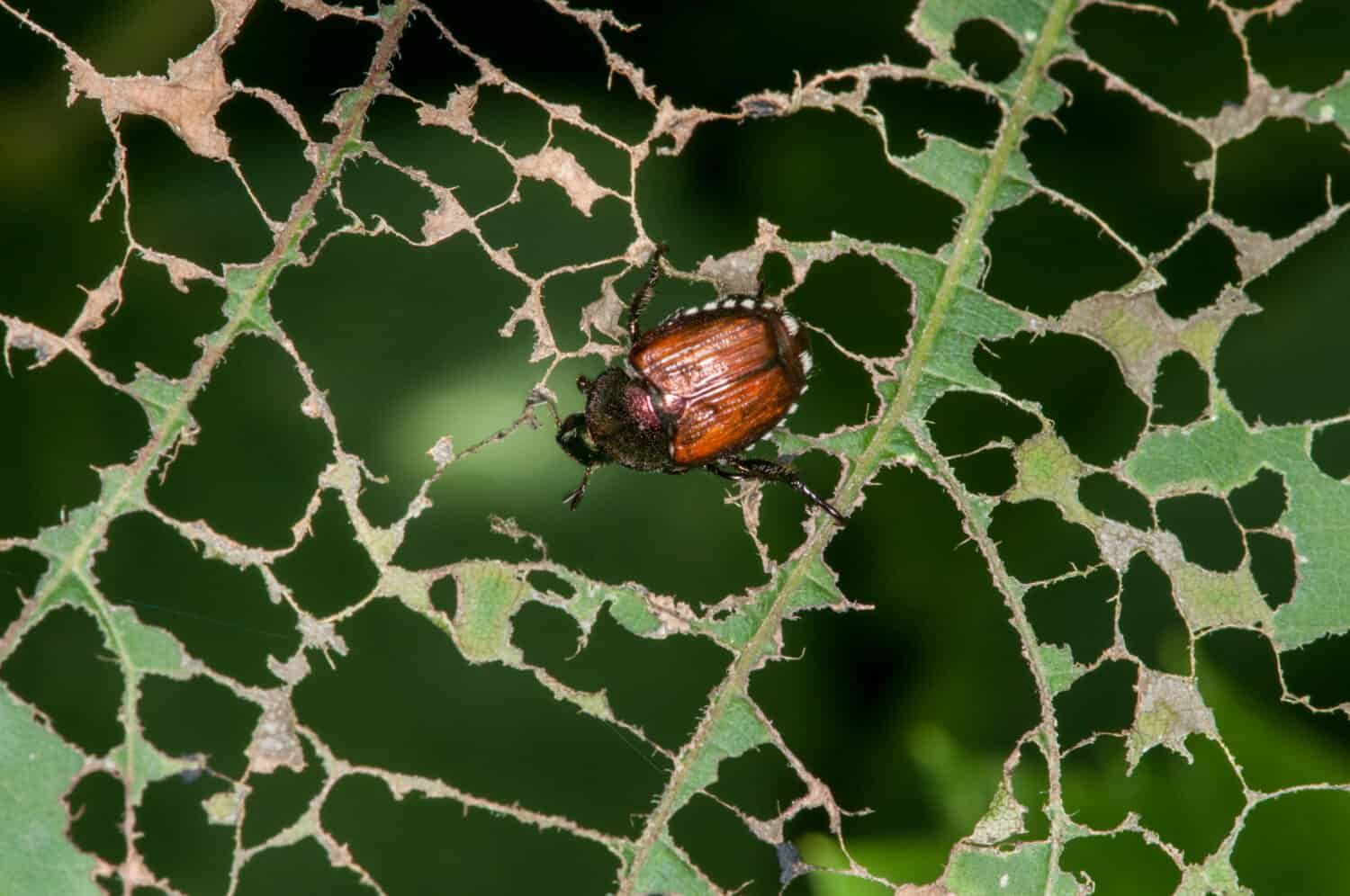
Japanese beetles are native to Japan.
©Michael Siluk/Shutterstock.com
Overview of the Japanese Beetle
Origins and Native Habitat of the Japanese Beetle
The Japanese beetle is native to Japan. Here, it is not a pest as natural predators control their populations with balance.
Japanese Beetles are an Invasive Species in North America and Europe
Japanese beetles, however, have proven to be highly invasive. They have been introduced to various parts of the world, causing concerns about their impact on local ecosystems. The invasion of Japanese beetles has been particularly pronounced in North America and Europe. They were first identified in the United States in 1916, likely arriving as larvae in infested soil around the roots of imported plants. Since then, their population has exploded, and they have become a widespread pest in many states. As of 2015, only nine western states have remained free and protected from the invasion of Japanese beetles. In 1939, these beetles were found in Nova Scotia and Quebec in Canada. As for Europe, Japanese beetles didn’t infiltrate the mainland until around 2014, when they were discovered in Italy. A few years later, in 2017, populations were found in Switzerland, which has since grown rapidly.
Characteristics of Japanese Beetles
Japanese beetles are characterized by their distinguished appearance. They are approximately 15 millimeters (0.6 inches) in length and 10 millimeters (0.4 inches) in width. Moreover, they exhibit a metallic green head and thorax with an iridescent copper-colored elytra. They also have a row of white spots of hair on each side of their body. This distinctive appearance makes them easily identifiable in the field. Furthermore, larvae are white, naturally lay in a c-shaped position when they reach the grub stage, and measure about 2.5 centimeters (1 inch) in length.
Dietary Preferences of Japanese Beetles
One of the most concerning aspects of Japanese beetles is their feeding habits. These insects are known for their insatiable appetite, consuming a wide range of plants. They are considered a pest that feeds on the leaves, flowers, and fruit of over 300 plant species. They have a strong preference for rose, grape, crabapple, cherry, plum, linden, and apple, as well as related trees, birch, elm, raspberry, currant, basil, hollyhock, marigold, Virginia creeper, corn silks, and even soybean. Moreover, the adults feed on the tissue material between a leaf’s veins, a concept known as skeletonizing the foliage. They also feed on plant fruit and flowers. The larvae, meanwhile, feed primarily on the roots of plants. Furthermore, adults often target many common crops, which significantly affects agriculture. Such crops include beans, tomatoes, peppers, corn, peas, okra, cannabis, strawberries, grapes, hops, roses, cherries, plums, pears, peaches, raspberries, blackberries, and blueberries.
Finally, as adults feed, they emit an odor that attracts more Japanese beetles. This often results in swarms of them congregating and feeding on plants. Plants have a certain tolerance for how many beetles and the damage they cause they can withstand. A high concentration of beetles can cause the decline or death of a plant.
Life Cycle and Nesting Habits of Japanese Beetles
Understanding the life cycle of Japanese beetles is crucial for effective management. Adult beetles emerge from the ground during the summer months, typically between June and July, and immediately start feeding on plants. After feeding, female beetles lay eggs in the top layers of soil. These eggs hatch into white larvae and mature into grubs. Grubs feed on fine plant roots and other organic material, causing further damage to the plants, grass, or crops above. In late autumn, the grubs burrow deeper into the soil to hibernate. The following spring, the grubs return to the surface to resume feeding before pupating and emerging as adult beetles.
Human Impact
Japanese beetles pose significant challenges to humans, both in agricultural and horticultural contexts. These insects can defoliate entire plants in a matter of days, leading to reduced crop yields and damaged ornamental gardens. Farmers and gardeners often resort to the use of pesticides to control Japanese beetle populations, which can have worse adverse effects on the environment and human health. However, there are natural methods one can use to deter these bugs, which we will get to in the next section.
Environmental Nuisance and Damage
In addition to their impact on agriculture and horticulture, Japanese beetles can also disrupt local ecosystems. As invasive species, they lack natural predators in their introduced habitats, allowing their populations to grow unchecked. This imbalance can lead to reduced biodiversity as native plants suffer from their relentless feeding.
Furthermore, the damage caused by Japanese beetles can extend beyond individual plants. When large numbers of beetles feed on a plant, they can weaken it to the point of death. This affects the plant itself and disrupts the habitat and food sources for other wildlife.
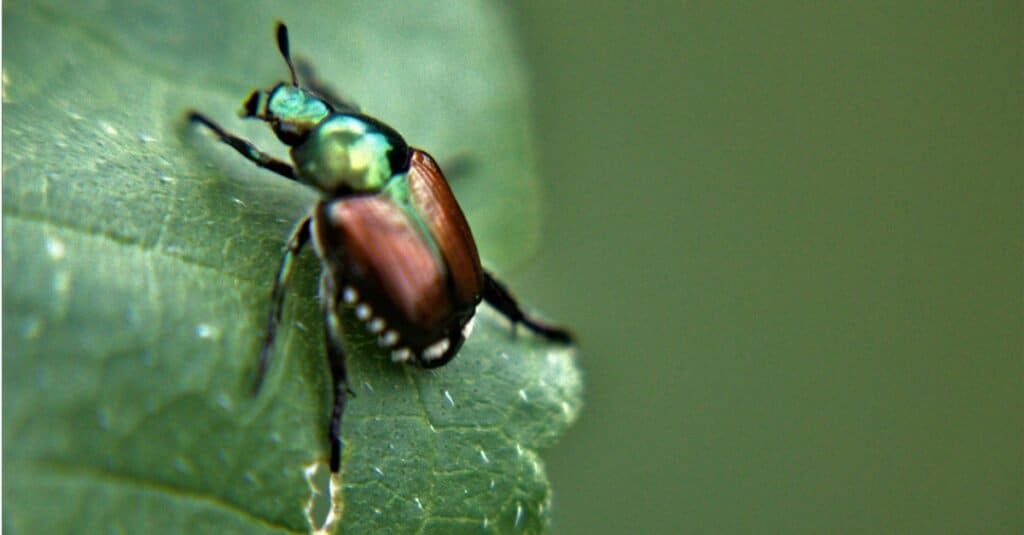
Japanese beetles are an invasive species in North America and Europe.
©iStock.com/Justin Tahai
Efforts to Control Japanese Beetle Populations
The invasion of Japanese beetles into human spaces has posed a significant challenge. These voracious pests threaten agriculture, horticulture, and local ecosystems. Various national and individual stakeholders, including government agencies, conservation entities, and citizens, have adopted a multifaceted approach combining scientific research, regulation, and community engagement to combat Japanese beetle infestations.
Government and Conservation Efforts
Regulation and Quarantine
One of the primary steps taken by governments is the regulation of plant material trade. For instance, the United States Department of Agriculture (USDA) enforces quarantine regulations to restrict the movement of plants, soil, and other potential carriers of Japanese beetle larvae. These measures aim to prevent the accidental introduction of the beetles into new areas.
Biological Control
Conservation entities and government agencies have explored the use of biological control agents to manage Japanese beetle populations. Natural parasites to Japanese Beetles, such as solitary wasps (Tiphia vernalis), have been introduced to target beetle larvae in the soil. The solitary wasp paralyzes the Japanese Beetle grub by stinging it and then lays its eggs on it. When the eggs hatch, the larvae feed on the grub and, thus, kill it. Moreover, the fly Istocheta aldrichi targets adult females to lay their eggs on the beetle’s thoraxes. When the eggs hatch, the larvae burrow into the female beetle’s body, which in turn kills it. This approach seeks to reduce beetle populations with a natural influence in a more environmentally friendly manner.
Research and Monitoring
Ongoing scientific research plays a pivotal role in understanding the behavior and biology of Japanese beetles. Government agencies, in collaboration with academic institutions, conduct extensive monitoring programs to track the spread of beetles and assess the effectiveness of control measures. This data informs decision-making and helps refine strategies.
Individual Efforts and Community Engagement
Integrated Pest Management (IPM)
The IPM is utilized at all levels, whether government or individual. At the individual level, homeowners, farmers, and gardeners can adopt IPM practices to manage Japanese beetle infestations. IPM involves a combination of strategies, including cultural practices (such as planting less preferred species), biological controls, chemical controls as a last resort, and consistent reevaluation and planning. This approach minimizes the environmental impact of pest control by combining a holistic approach with chemical options. It may not be perfect, but it is a process that, if used in good nature, prioritizes natural methods that work with the environment over toxic chemical methods that cause adverse effects on the environment.
Education and Awareness
Community engagement is critical in the fight against Japanese beetles. Local agricultural extension offices, conservation organizations, and gardening clubs often organize workshops and outreach programs to educate the public about beetle management strategies or implement strategies to protect their plants and crops. Awareness campaigns help individuals recognize the signs of beetle infestations and take appropriate action.
Reporting and Citizen Science
Many government agencies and conservation organizations encourage citizens to report sightings of Japanese beetles. This citizen science approach helps create a more comprehensive understanding of the beetles’ distribution and allows for more targeted control efforts.
Plant Selection
Per individual or business, plant selection can play a role in deterring Japanese beetles. Planting species that are less attractive to these pests can reduce the likelihood of infestations. Native plants are often a good choice, as they have evolved alongside local insect species and may be less appealing to invasive pests like Japanese beetles.
Challenges and Considerations
Despite these efforts, managing Japanese beetles remains a challenge. The beetles are highly adaptable, and their rapid reproduction rates can lead to population surges. Furthermore, the use of chemical pesticides, while effective, raises concerns about environmental impacts and the unintended harm they may cause to non-target species, including their effects on humans.
Addressing the invasion of Japanese beetles requires a collaborative approach involving governments, conservation entities, scientists, and individuals. Continued research into alternative control methods, such as biological agents, and the development of more sustainable pest management strategies are essential. Moreover, public awareness and active community engagement remain key components of any successful control effort.
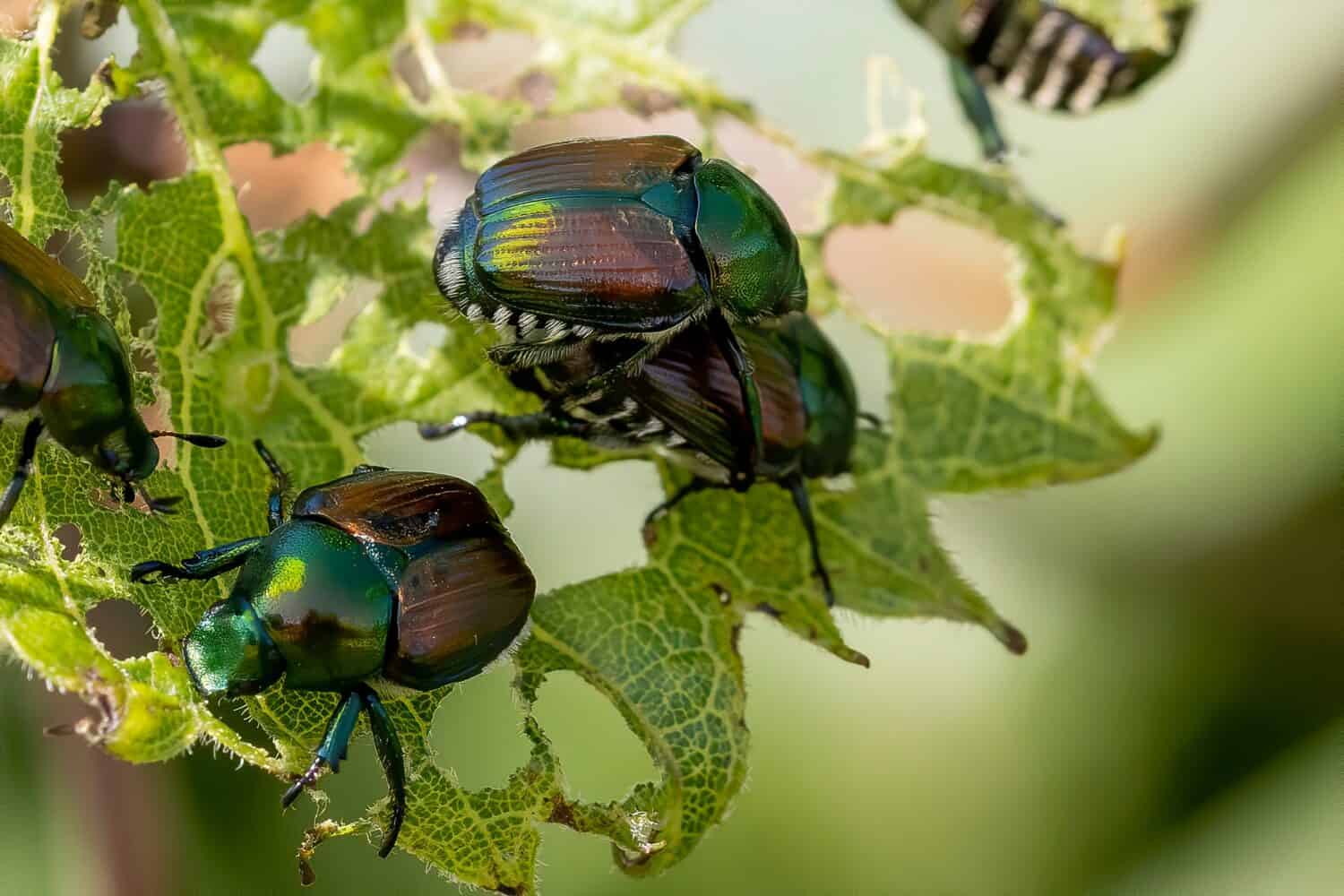
Japanese beetles hate the smell of garlic, onion, and chives.
©Karel Bock/Shutterstock.com
How to Repel Japanese Beetles With Smells
Utilizing smells that Japanese beetles hate can be an effective measure to help keep them away. This is because smells effectively repel Japanese beetles due to their sensitive antennae. They use their antennae to smell out favorable plants to feed on or find mates.
There are multiple ways to utilize smells to repel them, but keep in mind that these are pesky bugs that can pose a challenge to get rid of. Patience and persistence are necessary when working through any infestation or pest threat. Utilizing multiple methods and smells, not just one, two, or even three, will provide the most successful results.
The list below provides 30 smells that Japanese beetles hate that keep them away. Many of these items can be utilized in their plant form or as herbs (fresh or dry) or oils. You can plant them directly around your plants, create mixtures you can spray on or around your gardens, spread plant material in or around your garden, and more.
Furthermore, applying these scents in suitable locations will ensure their effectiveness. A strategy must be considered with these invasive insects.
Spraying, Planting, and Scattering
First, some tips for spraying include spraying the plant itself as well as all containers, pots, and hanging baskets. You can also spray any surrounding objects or even the perimeter of your garden. Additionally, you can add a carrier oil such as neem to the spray mixture to help the smell stick around longer, not to mention neem is a scent and texture itself that many insects, including the Japanese beetle, hate. Sprays can include a mixture of oils, fresh plant material, or dried plant material.
Second, you can form a border or scatter plants or plant material around or in your garden. Planting companion plants whose smells deter Japanese beetles is an effective long-term and broad-spectrum method. You can also scatter dried plant material, such as dried oregano herb, or freshly picked plant material, such as leftover freshly picked catnip.
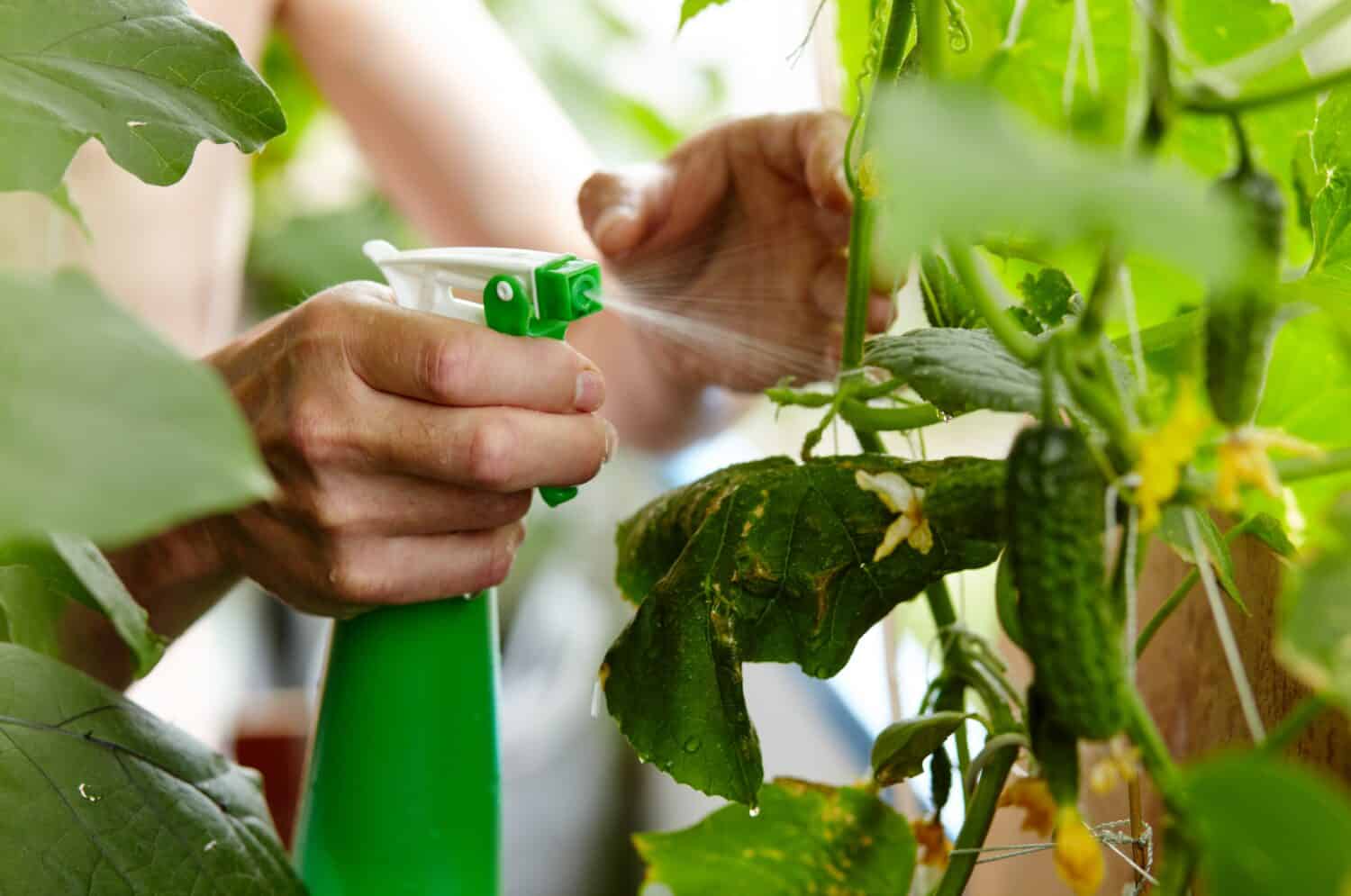
Japanese beetles hate the smell of many essential oils, including cedar wood, wintergreen, and oregano.
©Andrii Salomatin/Shutterstock.com
List of 30 Smells That Japanese Beetles Hate
Below is a list of 30 smells that Japanese beetles hate that will aid in keeping them away from your yard or garden.
| Plant or Oil |
|---|
| Neem |
| Anise |
| Bergamot Mint |
| Cedar Leaf |
| Dalmatian Sage |
| Wintergreen |
| Peppermint |
| Wormwood |
| Juniper Berry |
| Citronella |
| Cedar |
| Oregano |
| Catnip |
| Tarragon |
| Lemongrass |
| Basil |
| Dogwood Trees |
| Boxwood |
| Magnolia Trees |
| Cabbage |
| Rue |
| Larkspur |
| Onions |
| Leeks |
| Chives |
| Garlic |
| White Chrysanthemum |
| White Geraniums |
| Marigolds |
| Tansy |
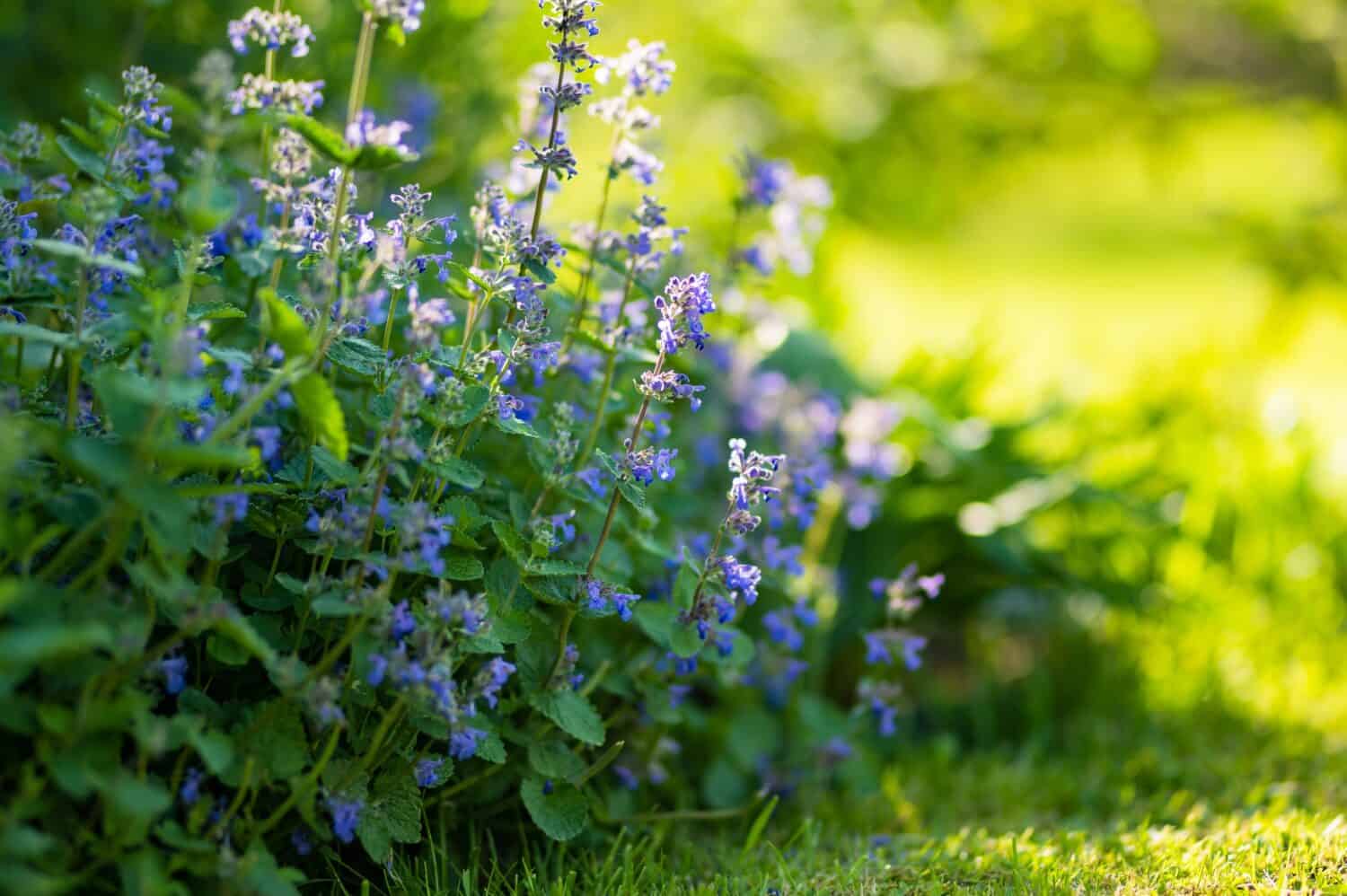
Japanese beetles hate the smell of catnip.
©MNStudio/Shutterstock.com
15 Methods That Repel Japanese Beetles
Japanese beetles have earned a notorious reputation for their voracious appetite, causing damage to a wide range of plants. Aside from just scents, there are additional effective methods to deter these invasive pests without resorting to harmful chemical pesticides. Moreover, utilizing scents along with these other methods can be most effective in successfully repelling Japanese Beetles with efficiency.
1. Neem Oil
Neem oil is a natural insect repellent that can deter Japanese beetles along with other pests. It disrupts their habits, specifically feeding, reducing their impact on plants. Combining neem oil, essential oils, water, and even potassium bicarbonate into a homemade spray can be an effective repellent if applied regularly.
2. Garlic and Garlic Spray
The pungent aroma of garlic can be effective in deterring Japanese beetles. Planting garlic near susceptible plants or using a homemade garlic spray can help keep these pests at bay. Applying this regularly is necessary to keep the lingering smell potent.
3. Companion Planting
Certain plants, such as marigolds, catnip, chives, garlic, marigold, white geranium, rue, tansey, and others listed in the previous section of smells, emit scents that repel Japanese beetles. Planting these companion plants alongside vulnerable crops and in gardens can help deter the pests.
4. Kaolin Clay
Kaolin clay forms a protective barrier on plants when mixed with water and sprayed onto leaves. This physical barrier makes it difficult for Japanese beetles to feed on treated plants.
5. Beetle Bags or Traps
Japanese beetle traps use a lure to attract the pests and then capture them in a bag. While these traps can be effective, they should be placed strategically, away from the plants you want to protect, to avoid drawing more beetles to the area.
6. Hand-Picking
Although labor-intensive, physically removing Japanese beetles from plants and dropping them into soapy water can be an effective method for small-scale infestations.
7. Row Covers
Row covers made of lightweight fabric can be used to physically block Japanese beetles from accessing plants. These covers allow sunlight and rain to reach the plants while keeping the beetles at bay. These are most popularly used for crops.
8. Beneficial Nematodes
Beneficial nematodes are microscopic worms that can be applied to the soil to control Japanese beetle grubs. They parasitize the grubs, preventing them from developing into adult beetles. The most effective nematodes are Steinernema glaseri and Heterorhabditis bacteriophora.
9. Essential Oils
Essential oils such as cedarwood, peppermint, wintergreen, and many others listed in the smells list above have repellent properties that may deter Japanese beetles. Mixing these oils with water and neem oil and spraying them on plants can help protect them from infestations.
10. Sound and Vibrations
Some gardeners have experimented with sounds and vibrations to deter Japanese beetles. Devices emitting ultrasonic sound waves or mechanical vibrations may disrupt and deter them.
11. Bird and Beneficial Insect Attractants
Attracting natural predators of Japanese beetles, such as birds, and beneficial insects, like wasps, can help control their populations. The following birds are known to target adults or larvae. They include starlings, grackles, cardinals, catbirds, crows, and gulls.
12. Strong-Scented Plants
Plants with strong scents, like rue and chives, as well as other plants from the smells listed above, can mask the odor of the plants Japanese beetles are attracted to, making it more challenging for them to locate their preferred hosts. Moreover, Japanese Beetles are deterred by the smell of these strong-scented plants.
13. Gardening Practices
Implementing good gardening practices, such as proper watering, pruning, and maintaining healthy soil, can make plants less attractive to Japanese beetles. Stressed or weakened plants are more susceptible to infestations.
14. Crop Rotation
Rotating crops from year to year can disrupt the life cycle of Japanese beetles. Since they lay their eggs in the soil near their preferred host plants, moving those plants to a different location can reduce the likelihood of infestations.
15. Timing
Being aware of the seasonal patterns of Japanese beetles is crucial. Early detection and intervention can prevent significant damage. Monitoring plants during the adult beetle’s feeding season (typically June to August) is essential.

Japanese beetles hate the smell of neem oil.
©Jake Benner/Shutterstock.com
Conclusion
In conclusion, there are many smells that Japanese beetles hate that keep them away. Natural scents like garlic, cedar wood, and peppermint, along with neem oil and plants like catnip and garlic, create a sensory barrier that discourages Japanese beetles from feasting on plants. Companion planting and homemade sprays are effective smell-based methods, while beneficial nematodes and other methods complement any strategy. All provide effective measures that, when utilized together, can result in successful management. By embracing these natural methods, individuals and larger entities can protect their gardens and crops while respecting the principles of sustainability and harmony with the Earth.
The photo featured at the top of this post is © Michael Siluk/Shutterstock.com
Thank you for reading! Have some feedback for us? Contact the AZ Animals editorial team.




